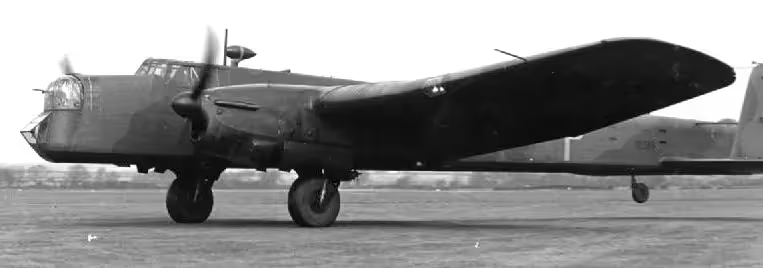Canadian Warplanes 4: Armstrong Whitworth AW.38 Whitley
Armstrong Whitworth AW.38 Whitley

(RAF Photo)
Armstrong Whitworth AW.38 Whitley.
The Whitley was in service with the RAF at the outbreak of the Second World War. It had been developed during the mid-1930s, and formally entered RAF squadron service in 1937. Following the outbreak of war in Sep 1939, the Whitley participated in the first RAF bombing raid on German territory and remained an integral part of the early British bomber offensive. By 1943, it was being superseded as a bomber by the larger four-engined heavy bombers such as the Avro Lancaster. Its front line service included maritime reconnaissance with Coastal Command and second line roles including glider-tug, trainer and transport aircraft. None have been preserved.(Wikipedia)

(RAF Photo)
Armstrong Whitworth Whitley Mk V of No. 19 Operational Training Unit based at Kinloss, Morayshire, parked at Abingdon, Berkshire, while visiting No. 10 OTU, September 1940.

(RAF Photo)
Armstrong Whitworth Whitley Mk Vs of No. 102 Squadron RAF being prepared for a leaflet-dropping sortie at Driffield, Yorkshire, 7 March 1940.

(RAF Photo)
Armstrong Whitworth Whitley Mk.I bomber (serial K7208) in flight, circa 1938. Its machine gun positions have been faired over.

(RAF Photo)
Armstrong Whitworth Whitley Mk. V bomber (Serial T4131, coded EY-W, from No. 78 Squadron c1940. Whitleys were flown by RCAF aircrew serving with the RAF, used as a tow-plane for gliders and for dropping paratroops. Ten flown with RCAF airmen onboard were lost on operations., with ten fatalities.

(IWM Photo, HU 104766)
Armstrong Whitworth Whitley Mk Vs of No. 102 Squadron during a press day at Driffield, March 1940. N1382 DY-A in the background was lost on a raid to Augsburg, 16/17 August 1940. The foreground aircraft is N1421 DY-C, which was shot down over Norway on the night of 29/30 April 1940.

(IWM Photo, HU 104769)
Armstrong Whitworth Whitleys of No. 102 Squadron during a press day at Driffield, March 1940.

(IWM Photo, 104768)
Armstrong Whitworth Whitley Mk V N1385 DY-P of No. 102 Squadron taking off during a press day at Driffield, March 1940.

(IWM Photo, HU 104767)
Armstrong Whitworth Whitleys of No. 102 Squadron refuelling during a press day at Driffield, March 1940.

(IWM Photo, HU 104648)
Armstrong Whitworth Whitley Mk IV P5004 of No. 77 Squadron RAF at RAF Topcliffe, 19 November 1940. This aircraft was lost on 25/26 June 1942 during the '1,000 bomber' raid on Bremen, while operating with No. 10 OTU.

(IWM Photo, C 918)
Mechanics overhauling the Rolls Royce Merlin X engines of an Armstrong Whitworth Whitley Mark V of No. 102 Squadron RAF at Driffield, Yorkshire. The front turret is a Nash and Thompson Type FN16.

(RAF Photo)
Parachute troops on parade in front of a Whitley bomber pressed into service in the airborne role, RAF Ringway, Manchester, January 1941.

(IWM Photo, H22785)
Paratroopers inside the fuselage of a Whitley aircraft at RAF Ringway, in the UK, August 1942. In 1940, the Whitley had been selected as the standard paratroop transport; in this role, the ventral turret aperture was commonly modified to be used for the egress of paratroopers. Members of the 1st Canadian Parachute Battalion would have been jumping from these aircraft during their training in the UK at RAF Ringway.

(RAF Photo)
Armstrong Whitworth AW.38 Whitley.

(IWM Photo, CH 226)
Armourers prepare 500-lb GP bombs on tractor-drawn trolleys, for loading into an Armstrong Whitworth Whitley Mark V of No. 58 Squadron RAF at Linton-on-Ouse, Yorkshire.

(IWM Photo, CH 2052)
Armstrong Whitworth AW.38 Whitley Mk. V (Serial No. T4162), coded DY-S, "Ceylon", of No. 102 Squadron RAF, on the ground at Topcliffe, Yorkshire. It failed to return from a bombing raid on Cologne on the night of 1/2 March 1941.

(IWM Photo, C 913)
The Nash and Thompson Type FN4 rear turret of an Armstrong Whitworth Whitley Mark V of No.102 Squadron RAF at RAF Driffield, Yorkshire, UK.

(IWM Photo, CH 242)
The crew of a Whitley of No 58 Squadron struggle into their flying kit in front of their aircraft, 17 June 1940.

(IWM Photo, CH 229)
Aircrew of No. 58 Squadron RAF load parachutes on board their Armstrong Whitworth Whitley Mk. V at Linton-on-Ouse, Yorkshire, prior to a sortie, 1 June 1940.

(IWM Photo, TR 105)
A crew of No. 78 Squadron, Royal Air Force watch as engine adjustments are made to an Armstrong Whitworth Whitley bomber Z6743 before they take off for a raid from Middleton St George, Durham, July 1941.





